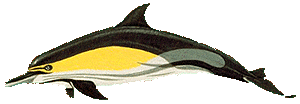
Common dolphin

Scientific
Name: Delphinus capensis
Other
Names: Saddleback dolphin, Criss-cross dolphin,
Cape dolphin
Length:
5.8-8 ft. (1.7-2.4 m.)
Weight:
155-245 lbs. (70-110 kg.)
Teeth:
160-240
Common
dolphins vary greatly in appearance. They
can grow to 2.1 m. in length and weigh up to 136 kg.
The
body has a distinctive pattern, a blue-black back, and a white abdomen
with 2 elliptical patches on the side. The anterior patch is yellow and
the posterior one is grey. A grey line also runs back from the eye to the
anus. A black stripe leaves the mid point of the lower jaw and travels
to the flippers, widening as it goes, leading into the trailing edge of
the flipper. The leading edge of the flipper is white. The fluke is blue.
There is a white stripe running from the blowhole towards the prominent
dorsal fin. The latter, often with a white central patch, is triangular,
but stops backwards at the tip. The first two neck bones are fused. There
are up to 100 teeth in each jaw. There are
two major varieties of common dolphins called the short beaked common dolphin
and the long beaked common dolphin. The body of the short beaked common
dolphin is slightly more robust and the head is more rounded. There are
also differences in behaviors and feeding patterns.
Man
has a long association with the cetaceans and in particular with the common
dolphin.
By
an accident of distribution it has lived close to the center of western
civilization for thousands of years. Although it is impossible to identify
with any certainty the species depicted on rocks in Norway dating from
2000 years B.C., there can be little doubt that many pictures of the smaller
cetaceans recorded in the art and decoration of the middle European civilizations
are of the common dolphin. In addiction they have become inextricably entwined
with mythology and legend. Arion's rescue by dolphins is a famous tale
from the Greek legends. Returning by ship to his home in Corinth from Italy,
with the spoils of his profession, he became the victim of a plot hatched
by jealous sailors.
Just
before he was to meet his doom, he made a request to play a final tune
on his lyre. As he played, he leaped into the sea. A dolphin, which the
legend claims, was listening to his music, carried him to shore and safety!
In
Greece, about 3200 B.C., they had already painted the dolphins on a wall
in the Palace of King Minos in Knossos(Kreta).
This
year i will add more information about this dolphin legend, because i'm
going there myself. There will be a full report of our holiday, and you
will be able to read all about it.
There
are a lot more stories about humans riding on dolphins. I am not going
to tell more about this legend. It also happens nowadays, for fun to play
with dolphins.
This
delightful, playful dolphin is widely distributed. It is found in the Atlantic,
where the population is estimated at more than 30.000, moving into the
Mediterranean and Black seas, and along the coast of Africa, around the
Cape into the Indian Ocean. It is also found in somewhat smaller numbers
in the Pacific. Migrating movements south to the North African coast in
summer, have been observed.